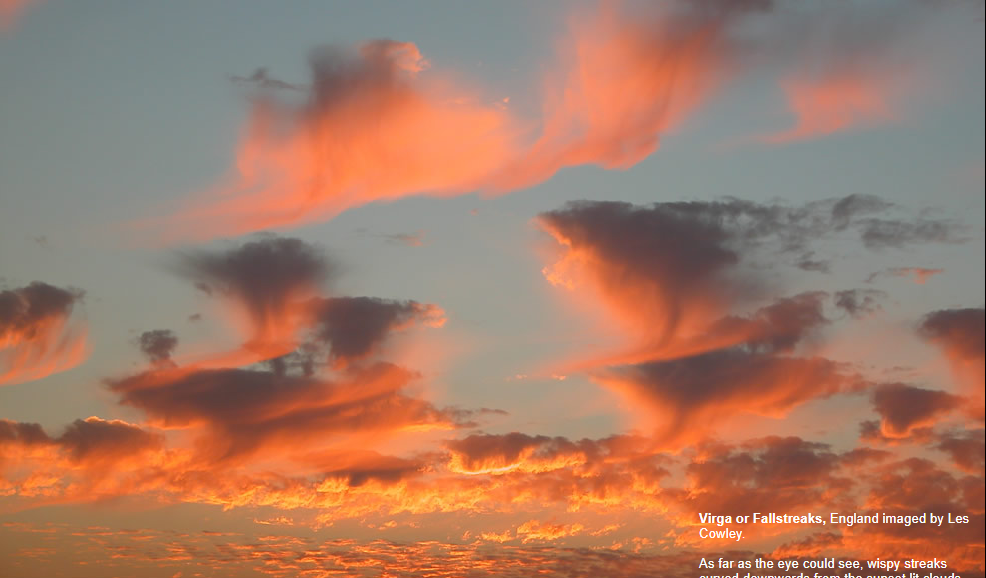Virga, fallstreaks
Virga and Fallstreaks: A Spectacular Atmospheric Phenomenon
Have you ever looked up at the sky and noticed wispy streaks curving downwards from the clouds, illuminated by the warm glow of the setting sun? These captivating formations are known as virga or fallstreaks, a mesmerizing atmospheric phenomenon that occurs when cloud precipitation fails to reach the ground. While they may appear as rain, snowflakes, or ice crystals forming halos, they dissipate before making contact with the Earth's surface.
Virga and fallstreaks can be observed from various levels of clouds, but they are most commonly seen in medium-level altocumulus, altostratus, and higher cirrus clouds. Their distinctive feature is their curved or hooked shape. This curvature is often a result of differences in wind speed with height, known as wind shear. Additionally, as water droplets or ice crystals evaporate and shrink, they fall at a progressively slower rate and eventually drift horizontally with the prevailing wind.
These ethereal phenomena provide a captivating spectacle for sky gazers and photographers alike. Let's delve deeper into the fascinating world of virga and fallstreaks to understand the science behind these enchanting displays:
-
Formation: Virga and fallstreaks are formed when precipitation particles within a cloud encounter dry air beneath them. As these particles descend, they evaporate due to the lower humidity levels, transforming from visible droplets or crystals into invisible water vapor.
-
Cloud Types: While virga and fallstreaks can occur in various cloud types, they are most commonly observed in altocumulus clouds, which are composed of water droplets at higher altitudes. These droplets freeze into ice crystals as temperatures drop, creating the perfect conditions for the formation of fallstreaks.
-
Wind Shear: Wind shear plays a crucial role in shaping the appearance of virga and fallstreaks. Variations in wind speed and direction at different altitudes cause the precipitation particles to be carried in different directions, resulting in their characteristic curved or hooked form.
-
Coloration: The color of virga and fallstreaks can vary depending on the angle of the sunlight and the presence of other atmospheric phenomena. When illuminated by the setting sun, they often exhibit vibrant hues, ranging from golden to pink and even purple, creating a stunning visual spectacle.
-
Optical Effects: The presence of virga and fallstreaks can also give rise to other atmospheric optical phenomena, such as crepuscular rays or sun dogs. These phenomena occur when sunlight interacts with ice crystals or water droplets in the vicinity of the fallstreaks, resulting in the scattering or bending of light.
-
Meteorological Significance: The presence of virga and fallstreaks can provide valuable insights into atmospheric conditions. Meteorologists often use their observations to assess cloud dynamics, wind shear patterns, and humidity levels, aiding in weather forecasting and analysis.
-
Photographic Opportunities: Virga and fallstreaks present photographers with a unique opportunity to capture breathtaking images of the sky. The interplay of light, cloud formations, and the elusive nature of these phenomena make them a favorite subject for both amateur and professional photographers.
-
Global Occurrence: Virga and fallstreaks can be observed worldwide, in diverse climatic regions and at various times of the year. Their occurrence is not limited to specific geographical locations, making them a fascinating subject for sky enthusiasts across the globe.
-
Educational Value: Studying virga and fallstreaks provides an excellent opportunity for individuals to deepen their understanding of meteorology and atmospheric optics. Exploring the science behind these phenomena can help cultivate an appreciation for the intricate workings of our atmosphere.
-
Appreciating Nature's Beauty: Ultimately, the allure of virga and fallstreaks lies in their ability to captivate our imagination and remind us of the awe-inspiring beauty of the natural world. Taking a moment to observe these enchanting displays can serve as a gentle reminder of the wonders that surround us every day.
In conclusion, virga and fallstreaks are a captivating atmospheric phenomenon that adds an ethereal touch to our skies. Understanding their formation, observing their characteristics, and appreciating their beauty can deepen our connection with nature and spark curiosity about the intricate mechanisms at play in our atmosphere. So, next time you find yourself gazing at the clouds, keep an eye out for the mesmerizing dance of virga and fallstreaks, and let yourself be swept away by their enchanting allure.

Virga or Fallstreaks, England imaged by Les Cowley.
As far as the eye could see, wispy streaks curved downwards from the sunset lit clouds.
Virga or fall streaks are cloud precipitation that does not reach the ground. They can be rain, snowflakes or halo forming ice crystals.
They can be seen from all levels of cloud but more usually from medium level altocumulus, altostratus and from higher cirrus.
Fallstreaks are characteristically curved or hooked. Differences in wind speed with height (wind shear) can be responsible and another factor is that as the water droplets or ice crystals evaporate and shrink they fall ever more slowly and finally drift horizontally with the wind.
Note: this article has been automatically converted from the old site and may not appear as intended. You can find the original article here.
Reference Atmospheric Optics
If you use any of the definitions, information, or data presented on Atmospheric Optics, please copy the link or reference below to properly credit us as the reference source. Thank you!
-
<a href="https://atoptics.co.uk/blog/virga-fallstreaks/">Virga, fallstreaks</a>
-
"Virga, fallstreaks". Atmospheric Optics. Accessed on November 21, 2024. https://atoptics.co.uk/blog/virga-fallstreaks/.
-
"Virga, fallstreaks". Atmospheric Optics, https://atoptics.co.uk/blog/virga-fallstreaks/. Accessed 21 November, 2024
-
Virga, fallstreaks. Atmospheric Optics. Retrieved from https://atoptics.co.uk/blog/virga-fallstreaks/.